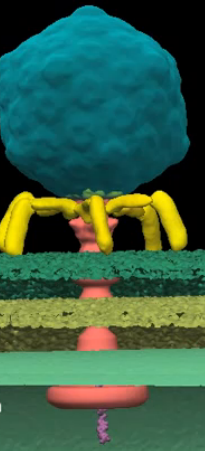Virus caught in the act of infecting a cell
January 11, 2013

T7 virus injects its DNA into a cell in this frame from an animation (credit: Bo Hu)
The detailed changes in the structure of a virus as it infects an E. coli bacterium have been observed for the first time.
To infect a cell, a virus must be able to first find a suitable cell and then eject its genetic material into its host.
This robot-like process has been observed in a virus called T7 and visualized byIan Molineux, professor of biology in the College of Natural Sciences at The University of Texas at Austin, and colleagues at The University of Texas Health Science Center at Houston (UT Health) Medical School.
When searching for its prey, the virus briefly extends — like feelers — one or two of six ultra-thin fibers it normally keeps folded at the base of its head.
Once a suitable host has been located, the virus behaves a bit like a planetary rover, extending these fibers to walk randomly across the surface of the cell and find an optimal site for infection — the first experimental evidence for this.
At the preferred infection site, the virus goes through a major change in structure in which it ejects some of its proteins through the bacterium’s cell membrane, creating a path for the virus’s genetic material to enter the host./.../
No comments:
Post a Comment